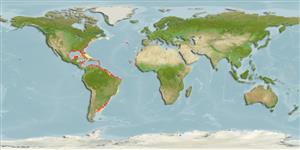Preferred temperature (Αναφ.
123201): 12 - 27.9, mean 24.4 °C (based on 656 cells).
Phylogenetic diversity index (Αναφ.
82804): PD
50 = 0.5078 [Uniqueness, from 0.5 = low to 2.0 = high].
Bayesian length-weight: a=0.01288 (0.01151 - 0.01441), b=2.96 (2.93 - 2.99), in cm total length, based on LWR estimates for this species (Ref.
93245).
Τροφικό Επίπεδο (Αναφ.
69278): 3.7 ±0.52 se; based on food items.
Generation time: 2.2 ( na - na) years. Estimated as median ln(3)/K based on 1
growth studies.
Ελαστικότητα (Αναφ.
120179): Μεσαίο(α), ελάχιστος χρόνος για διπλασιασμό πληθυσμού 1,4 - 4,4 έτη (tmax=4.5; assuming tm=2-3).
Prior r = 0.54, 95% CL = 0.36 - 0.81, Based on 2 data-limited stock assessments.
Fishing Vulnerability (Ref.
59153): Low to moderate vulnerability (29 of 100).
🛈
Climate Vulnerability (Ref.
125649): Moderate vulnerability (36 of 100).
🛈
Nutrients (Ref.
124155): Calcium = 72.3 [42.4, 149.2] mg/100g; Iron = 1.18 [0.66, 2.21] mg/100g; Protein = 18.5 [16.6, 20.8] %; Omega3 = 0.381 [0.226, 0.665] g/100g; Selenium = 30 [16, 56] μg/100g; VitaminA = 9.4 [3.0, 26.4] μg/100g; Zinc = 0.828 [0.587, 1.182] mg/100g (wet weight);
